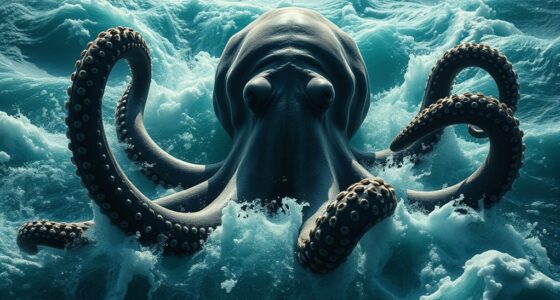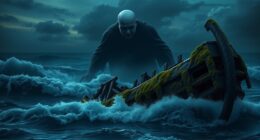Across cultures, maritime legends from mermaids to sirens reflect humanity’s fascination and fears about the sea’s mysteries. These stories often depict spirits or creatures that lure, warn, or guide sailors, blending folklore, supernatural elements, and cultural values. They serve as warnings, entertainment, or expressions of community identity, showing respect for nature’s power. If you keep exploring, you’ll uncover even more tales that reveal the sea’s timeless influence on human imagination and tradition.
Key Takeaways
- Maritime legends often feature mermaids and sirens as supernatural beings symbolizing allure, danger, and the mysteries of the sea across cultures.
- European folklore depicts ghostly ships and sailor spirits, blending tales of treasure and revenge linked to wrecked vessels.
- Caribbean legends include mermaids and sirens that lure sailors, reflecting regional beliefs about the sea’s enchantment and peril.
- Cultural interpretations of mermaids and sirens vary, often embodying community values, fears, and respect for the ocean’s power.
- These legends serve as moral lessons, cultural identity markers, and narratives that preserve maritime heritage worldwide.

Across cultures around the world, maritime legends have long captured our imagination, revealing the deep connection between humanity and the sea. These stories often emerge from shipwreck stories and coastal folklore, serving as cautionary tales, mysteries, or reflections of cultural values. When you hear about shipwrecks, it’s not just about the sinking vessels; it’s about what the wrecks symbolize—human hubris, nature’s power, or the unknown depths that hide secrets beneath the waves. Coastal communities have spun these stories over generations, transforming tragic accidents into legends that warn, entertain, or teach moral lessons.
Maritime legends reveal humanity’s deep bond with the sea through stories of shipwrecks and coastal folklore.
In many coastal folklore traditions, shipwrecks are seen as more than accidents—they’re gateways to the supernatural. You might hear stories where spirits of sailors haunt the shores, warning others of impending danger or guiding lost souls back to safety. Such tales often reinforce the idea that the sea isn’t just a vast body of water but a living entity, capable of both destruction and benevolence. These legends help communities cope with the dangers of maritime life, turning tragedies into meaningful stories that foster a sense of shared history and resilience.
Across different cultures, these shipwreck stories take on various forms. In European maritime folklore, wrecked ships often become the setting for ghost stories or treasure tales, where sailors’ spirits are believed to linger, seeking redemption or revenge. In the Caribbean, stories of shipwrecks are intertwined with tales of mermaids and sirens—mythical beings that lure sailors to their doom or offer aid from the depths. Such legends highlight how maritime communities interpret the sea’s mysteries, blending fear, fascination, and reverence into cultural narratives.
These stories also serve as a way to preserve cultural identity and history. When you explore coastal folklore, you find that shipwreck stories are often passed down orally, reinforced by local traditions and festivals. They become part of the community’s identity, shaping how people view the sea—either as a treacherous adversary or a source of wonder. These legends underscore the importance of respecting nature’s power and recognizing that the sea’s mysteries are intertwined with human stories of survival, loss, and hope.
Ultimately, maritime legends rooted in shipwreck stories and coastal folklore give voice to humanity’s complex relationship with the sea. They remind us that beneath the surface lies a world full of stories waiting to be uncovered—stories that continue to captivate and inspire, just as they have for generations. Additionally, these legends often reflect cultural values and societal norms, shaping how communities perceive and interact with the maritime environment.
Frequently Asked Questions
How Did Mermaid Legends Originate in Ancient Civilizations?
You might find that mermaid legends originate from ancient civilizations through myths rooted in mythical origins and ancient symbolism. Early sailors and coastal communities likely spread stories of half-human, half-fish beings to explain mysterious sea phenomena or to symbolize the allure and danger of the ocean. These tales evolved over time, blending cultural beliefs and symbolic meanings, creating enduring legends that reflect humanity’s fascination with the sea and its mysteries.
Are Siren Stories Connected to Real Historical Events?
You might wonder if siren stories are rooted in reality. While there’s no direct link to actual events, shipwreck narratives and sailors’ superstitions fuel these legends, like echoes of truth lost at sea. Sailors often believed mysterious sounds or sightings were sirens warning of danger, turning myth into a haunting symbol of peril. These tales, like shadows in fog, blur fact and fiction, enthralling imaginations across ages.
What Cultural Differences Exist in Mermaid Depictions Worldwide?
You’ll notice cultural differences in mermaid depictions through their unique symbolism and artistic representations. In Western cultures, mermaids often symbolize beauty and danger, shown with alluring features and fish tails. Meanwhile, Asian portrayals focus on spiritual symbolism, emphasizing wisdom and protection with more serene, human-like figures. These variations reflect each culture’s beliefs, values, and artistic styles, shaping how mermaids are celebrated and understood worldwide.
How Have Maritime Legends Influenced Modern Ocean Folklore?
Did you know that about 60% of ocean stories incorporate elements of marine mythology? Maritime legends heavily influence modern ocean folklore, shaping how people perceive the sea’s mysteries. You’re likely to encounter nautical storytelling that echoes ancient tales of sirens and mermaids, blending myth with reality. These stories persist because they connect us to the ocean’s allure, inspiring movies, books, and cultural traditions that keep maritime legends alive today.
Are There Any Scientific Explanations for Mermaid Sightings?
There are no solid scientific explanations for mermaid sightings, but marine biology offers some clues. Many sightings could be optical illusions caused by waves, floating debris, or marine animals like manatees and dugongs, which can resemble mermaids from a distance. These natural phenomena create illusions that captivate sailors and explorers, fueling legends. So, it’s likely that many mermaid stories stem from misidentifications of marine life or optical illusions in the ocean.
Conclusion
So, next time you hear a story about mermaids or sirens, remember—they’re just the ancient world’s way of warning you to stay away from mysterious waters. Whether they lure sailors to their doom or just make great stories, one thing’s clear: humans have always loved a good myth to keep us from venturing too far. After all, who needs real adventure when you can chase tales spun by creatures of the deep?










